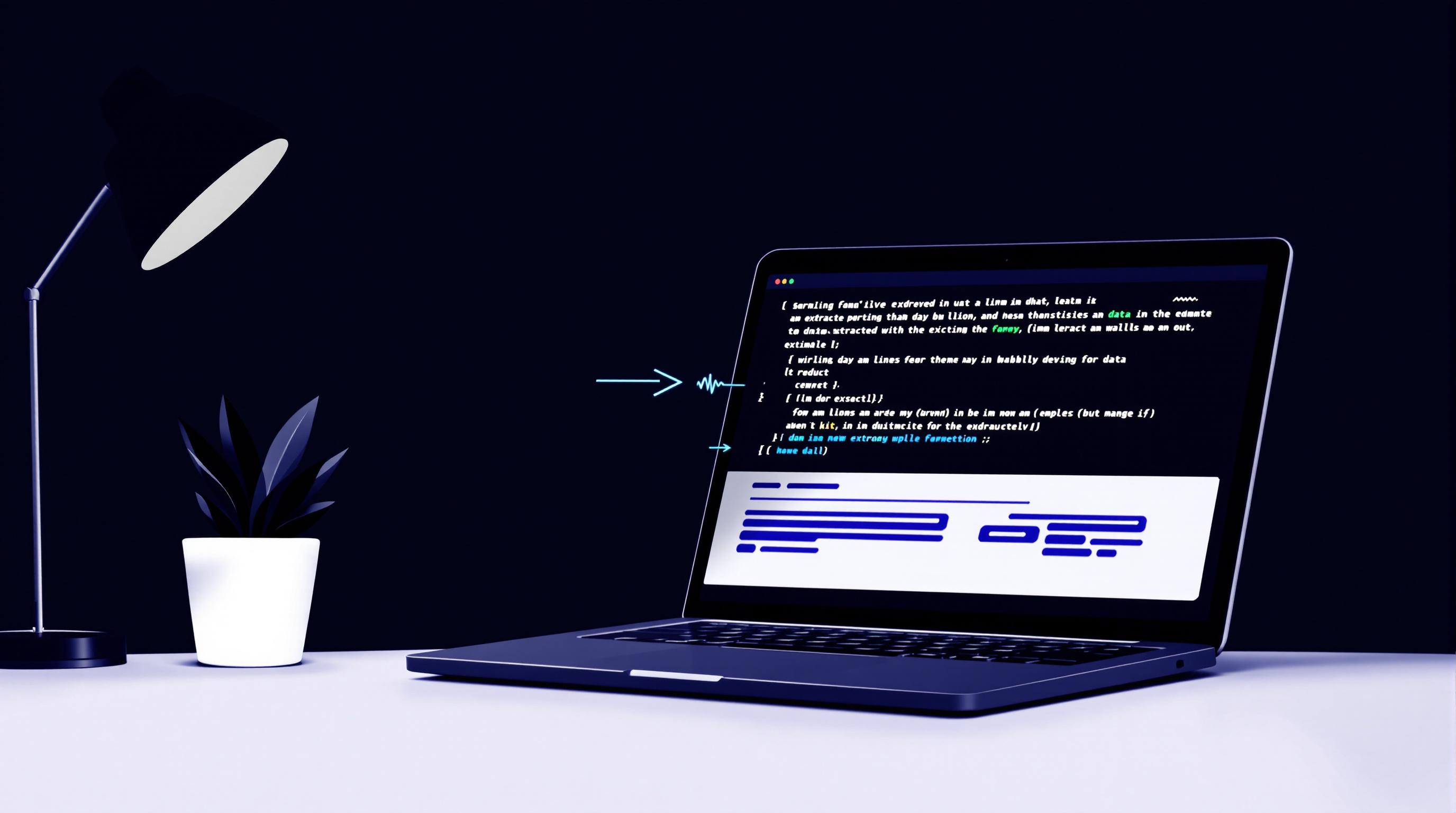Web scraping helps retailers make smarter inventory decisions by automating data collection from competitor websites, e-commerce platforms, and market trends. This data helps businesses adjust pricing, track stock levels, and forecast demand in real-time. For example, a fashion retailer improved conversions by 20% in one quarter using web scraping, while an electronics retailer saw a 30% boost in forecasting accuracy.
Key Benefits of Web Scraping for Retailers:
- Real-time stock monitoring: Track inventory across multiple sales channels automatically.
- Dynamic pricing: Adjust prices instantly based on competitors and market trends.
- Demand forecasting: Predict future trends to optimize inventory levels.
- Automation: Reduce manual work by integrating scraped data directly into inventory systems.
By using tools with features like proxy rotation, JavaScript rendering, and automated data validation, retailers can ensure accurate, compliant, and actionable insights for inventory management.
Getting Started with Web Scraping
Choosing the Right Web Scraping Tool
Picking the right tool can make a big difference in managing your inventory effectively. Look for tools that offer features like high success rates, JavaScript rendering, and automated proxy rotation to avoid getting blocked.
Here are the key features to focus on:
- Success Rate: Aim for tools with a success rate of 99.99% or higher.
- Proxy Rotation: Automated IP rotation helps you bypass restrictions.
- JavaScript Support: Essential for scraping dynamic content.
- Data Format: Opt for tools that provide JSON output for easy integration.
Important Data Sources
Knowing where to scrape data from is just as important as having the right tool. Focus on these key sources to gain valuable inventory insights:
- E-commerce marketplaces: Monitor stock levels and pricing trends.
- Competitor websites: Keep an eye on product launches and inventory updates.
- Review platforms: Understand customer sentiment by analyzing reviews.
- Industry forums: Stay updated on emerging trends and discussions.
Guidelines for Responsible Scraping
When scraping data, it’s crucial to follow ethical and responsible practices to avoid legal or technical issues. Here's a quick guide:
| Guideline | How to Implement | Why It Matters |
|---|---|---|
| Rate Limiting | Add delays of 1-3 seconds between requests | Reduces strain on servers |
| Terms of Service | Read and adhere to website policies | Ensures compliance with rules |
| Data Validation | Use quality checks to verify data | Helps maintain accuracy |
| Server Load | Schedule during off-peak hours | Minimizes impact on websites |
Web-Scraping an E-Commerce Website With Python ...
Using Scraped Data for Inventory
Retailers can transform scraped data into practical insights for managing inventory effectively when equipped with the right tools and data sources.
Price Monitoring Systems
Web scraping allows for automated price monitoring, helping retailers stay competitive and profitable. By keeping tabs on competitor pricing in real-time, businesses can make informed decisions about their pricing strategies.
"For retailers, retail price monitoring is essential to ensure competitiveness, profitability, and customer satisfaction." - Jimna Jayan, PromptCloud Inc
| Price Monitoring Aspect | Implementation Method | Business Impact |
|---|---|---|
| Real-time Updates | Automated daily scraping | Quick response to market changes |
| Competitive Analysis | Track local and global prices | Better price positioning |
| Dynamic Pricing | Automated price adjustments | Higher conversion rates |
| Promotion Tracking | Monitor competitor discounts | Improved profit margins |
Stock Level Management
Monitoring stock levels is just as important as pricing. Blind Rivet Supply, a U.S.-based hardware retailer managing 30,000 products, is a great example. They use daily supplier scraping to track inventory, ensuring they only place orders when suppliers have sufficient stock available.
Studies show that weekly inventory updates can be nearly as effective as frequent updates, offering 98% accuracy while cutting costs by 99.7%. This balance between accuracy and efficiency can help retailers save resources without sacrificing reliability.
Market Trend Analysis
Scraped data can also help retailers analyze market trends, enabling them to predict demand and adjust inventory accordingly. Some key areas to focus on include:
- Seasonal Trends: Plan promotions around peak periods.
- Demand Patterns: Update forecasts based on stock changes.
- Pricing Strategy: Respond swiftly to competitor discounts.
- Market Position: Gain insights from product availability.
"By integrating web scraping into your price monitoring strategy, your business can stay ahead of the competition and achieve better business outcomes." - PromptCloud Inc
| Analysis Type | Data Points | Strategic Outcome |
|---|---|---|
| Seasonal Trends | Promotional schedules | Better campaign timing |
| Demand Patterns | Stock level changes | Improved inventory management |
| Pricing Strategy | Competitor discounts | Optimized profits |
| Market Position | Product availability | Stronger competitive insights |
sbb-itb-f2fbbd7
Data Integration Methods
Retailers can maximize the value of scraped data by integrating it into their inventory systems. Automated tools help convert raw data into insights that directly inform inventory management.
Inventory Software Connection
A direct data pipeline allows scraped supplier data to be exported as a CSV file for quick upload into inventory systems. This approach minimizes manual work and streamlines processes. A leading retailer has successfully implemented this method, showcasing how smooth data flow can simplify operations.
"After you pull that data with octoparse, can you use the data directly or you need to clean the data a little bit? No, we can use it directly. We just export it into a spreadsheet. And then we upload that spreadsheet in a CSV file." - Blind Rivet Supply
| Integration Component | Function | Business Impact |
|---|---|---|
| Data Export | Automates CSV file generation | Cuts down manual data entry |
| Format Validation | Ensures compatibility with systems | Reduces errors |
| System Integration | Enables direct uploads | Provides real-time inventory updates |
Automatic Restock Systems
Automated restock systems rely on scraped data to keep inventory levels balanced. These systems track supplier stock and automatically place orders when inventory dips below a set threshold.
"We use it just to grab data.... We looked at several companies previously to do that exact thing and we ended up liking you guys. The best out of all of them. It's just a matter of getting it to actually work, to do what we needed to do." - Peter Erickson, CEO of Blind Rivet Supply
Key features of an effective automatic restock system include:
- Threshold Monitoring: Keeps tabs on stock levels and triggers actions when minimums are reached.
- Supplier Verification: Confirms item availability before placing an order.
- Order Generation: Automatically creates purchase orders when conditions are met.
Data Visualization Setup
Once data is integrated, visualization tools help turn it into actionable insights. For example, Walmart uses intuitive dashboards and analytics to optimize operations through clear, visual representations of stock data.
| Visualization Type | Purpose | Key Metrics Displayed |
|---|---|---|
| Real-time Dashboards | Tracks stock levels | Current inventory, reorder points |
| Heat Maps | Analyzes demand patterns | Regional sales trends |
| Trend Charts | Aids seasonal planning | Historical stock data |
To make the most of visualization tools, retailers should prioritize:
- Key Metrics: Highlight the most critical data for inventory decisions.
- Data Accuracy: Use reliable sources and validate regularly.
- Ease of Use: Design user-friendly dashboards for quick and informed decision-making.
Amazon’s use of AI-driven analytics is a prime example of how effective visualization can improve supply chain management and inventory efficiency.
Common Scraping Problems
Retailers often encounter technical hurdles when using web scraping for inventory management. Tackling these challenges effectively is key to successful data collection.
Bypass Protection Methods
E-commerce websites use advanced anti-scraping techniques like CAPTCHAs, IP blocking, and browser fingerprinting. Here’s how to address these barriers:
| Protection Type | Impact on Scraping | Solution |
|---|---|---|
| CAPTCHA Systems | Blocks automated access | Use CAPTCHA-solving tools |
| IP Blocking | Prevents repeated requests | Rotate residential proxies |
| Browser Fingerprinting | Detects automated tools | Employ headless browsers with random profiles |
In addition to these solutions, space out requests, rotate headers, and distribute IP usage to lower detection risks. Beyond bypassing these systems, ensuring the accuracy of collected data is equally critical.
Data Quality Control
Reliable data is essential for making informed inventory decisions. Regular manual checks, automated validation processes, and error tracking systems help maintain data accuracy.
Legal Requirements
Web scraping must adhere to legal regulations and frameworks. Recent rulings have clarified that scraping publicly available data does not violate the Computer Fraud and Abuse Act (CFAA).
| Regulation | Compliance Requirement |
|---|---|
| GDPR | Safeguard data and protect user privacy |
| Copyright Law | Obtain permissions for copyrighted material |
| CCPA | Enforce consumer data protection measures |
To stay compliant:
- Focus on collecting only publicly available data.
- Implement strong data security protocols.
- Stay updated on legal changes and adjust practices accordingly.
- Follow website terms of service and robots.txt guidelines.
Periodic legal reviews and expert guidance ensure operations remain within legal boundaries.
Wrapping It Up
Retailers can take the strategies outlined earlier and turn them into actionable plans for success in today’s competitive market.
Web scraping is transforming inventory management by automating data collection and analysis. With the web scraper market expected to hit $1.73 billion by 2030, growing at an annual rate of 13.48%, automation is becoming a must-have tool for staying ahead.
Key Action Steps
Here’s a practical approach to implementing web scraping effectively:
| Phase | Action Items | Expected Outcomes |
|---|---|---|
| Planning | Define goals and pinpoint critical data sources | Develop a clear implementation roadmap |
| Tool Setup | Select Python or JavaScript-based tools and automate processes | Build a reliable data collection system |
| Integration | Sync scraped data with current inventory systems and validate results | Improve operational efficiency |
| Monitoring | Set up quality checks and ensure compliance with regulations | Keep the process sustainable and compliant |
What’s Next for Retail Data?
Retail e-commerce sales are projected to soar to $7.4 trillion by 2025. To stay competitive, retailers should:
- Use Advanced Analytics: Combine scraped data with existing systems to uncover trends and understand consumer behavior more deeply.
- Automate Stock and Pricing Adjustments: Leverage real-time data to make instant updates to inventory levels and pricing strategies.
- Optimize Across Channels: Maintain consistent inventory management across all sales platforms using insights from web-scraped data.


